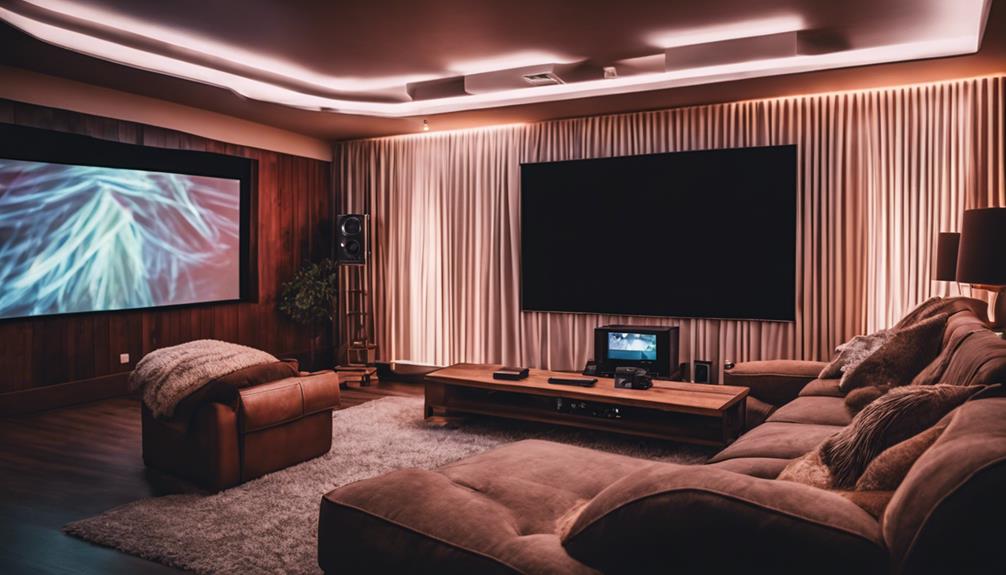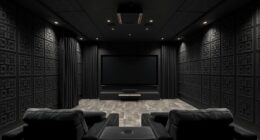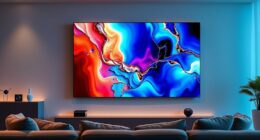HDR elevates your home cinema viewing experience by delivering brilliant color and enhanced contrast. You'll notice deeper blacks and brighter whites that add depth to every scene. With a broader color gamut, films come alive, making viewing considerably more engaging. Whether you're enjoying HDR10 or Dolby Vision, the dynamic tone mapping guarantees you see details you might've missed before. Plus, with many streaming services now offering HDR content, it's easier than ever to access stunning visuals. If you're curious about how to optimize your setup or the latest trends in HDR, there's even more to discover.
Key Takeaways
- HDR significantly enhances contrast, providing deeper blacks and brighter whites for a more immersive viewing experience.
- The expanded color gamut in HDR technology results in vibrant, lifelike colors that enrich the cinematic atmosphere.
- Increased detail in bright and dark areas due to higher contrast ratios improves overall picture quality and visual depth.
- Major streaming services and UHD Blu-ray offer a growing library of HDR content, making it more accessible for home cinema enthusiasts.
Understanding HDR Technology
When you plunge into HDR technology, you'll discover how it dramatically enhances the contrast and color of your home cinema experience. High Dynamic Range (HDR) provides enhanced contrast, allowing for a more significant difference between the brightest whites and the deepest blacks. This means that when you're viewing content, you'll notice details in shadowed and highlighted areas that standard dynamic range (SDR) often misses.
With HDR, lifelike colors come to the forefront, thanks to the expanded color gamut that boosts color saturation and overall visual realism. You'll find that HDR formats like HDR10 and Dolby Vision utilize advanced techniques such as dynamic tone mapping to optimize brightness and color levels on a frame-by-frame basis, ensuring you're getting the best possible image quality.
Incorporating HDR into your home theater system is essential for achieving that true cinematic experience. It transforms how you engage with films and shows by adding visual depth and emotional richness.
Benefits of HDR in Home Cinema

HDR brings a multitude of benefits to your home cinema, transforming how you experience movies and shows with stunning visuals and enhanced realism.
With HDR technology, you'll enjoy a more immersive viewing experience thanks to deeper blacks and brighter whites that capture subtle details often lost in traditional displays. The increased contrast ratio allows you to see greater detail in both dark and bright areas, enriching the textures and overall image quality for a true cinematic effect.
One of the standout features of HDR is its ability to deliver vibrant colors through a wider color gamut, resulting in lifelike images that enhance the atmosphere of your favorite films and series. As HDR content becomes increasingly available on major streaming services and UHD Blu-ray discs, accessing high-quality visuals for your home cinema setup has never been easier.
The advanced processing techniques employed in HDR not only improve image depth but also contribute to the enhanced picture quality, making every viewing session more engaging.
With HDR, you're not just watching a movie; you're stepping into a world where every scene comes to life like never before.
Choosing the Right HDR Format

Choosing the right HDR format can greatly enhance your home cinema experience, so it's essential to understand the options available. One of the most widely adopted formats is HDR10, which provides a consistent viewing experience across various devices.
However, if you want enhanced picture quality, consider Dolby Vision, which uses dynamic metadata for frame-by-frame optimization, ensuring that cinematic colors pop based on scene requirements.
Another option is HDR10+, an open standard that offers improved performance over traditional HDR10, making it a great choice for those seeking flexibility.
If you're into live broadcasts, Hybrid Log-Gamma (HLG) is designed for that purpose, allowing compatibility with both HDR and non-HDR displays without needing separate content.
When choosing an HDR format, compatibility with your existing equipment is essential. Not all devices, including projectors, support every HDR standard, which can considerably affect your overall viewing experience.
Essential HDR-Compatible Equipment
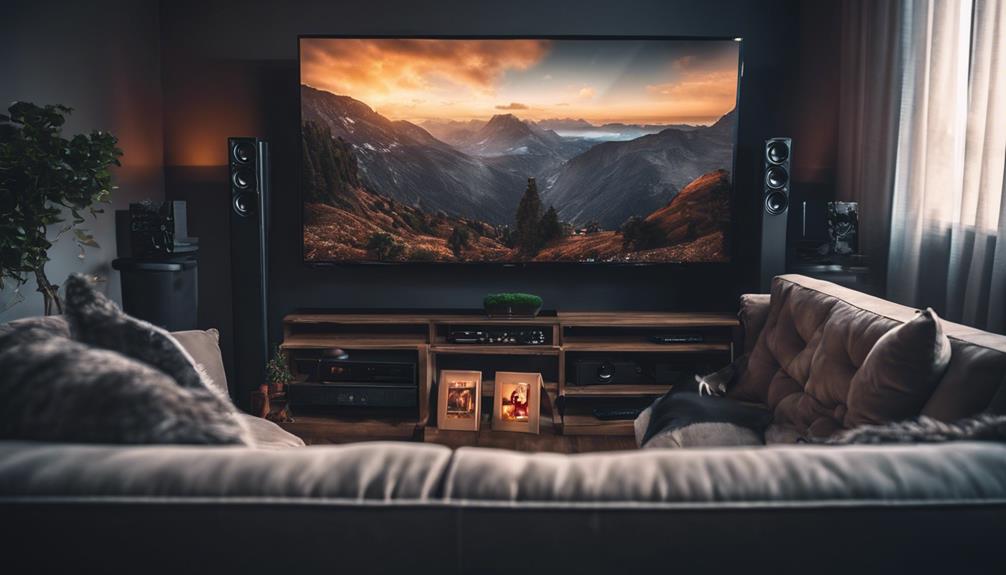
To fully enjoy the benefits of HDR content, you'll need the right equipment that can display and process these advanced visuals effectively. Start with an HDR-compatible television or projector, which is essential for showcasing HDR content's vibrant colors and brightness. To transmit HDR signals, invest in High-Speed HDMI cables (HDMI 2.0 or 2.1) that support the necessary bandwidth.
Your media players and streaming devices should also be compatible with HDR formats like HDR10, Dolby Vision, or HLG to guarantee you can access the best content available. Additionally, consider upgrading your audio setup to support formats like Dolby Atmos, enhancing your immersive cinematic experience.
Lastly, don't overlook your room setup. Reducing ambient light with blackout curtains will preserve detail in shadows and highlights, allowing you to fully appreciate the HDR visuals.
| Equipment Type | Purpose | Recommendations |
|---|---|---|
| HDR-compatible television | Displays HDR content effectively | OLED or QLED options |
| High-Speed HDMI cables | Transmits HDR signals | HDMI 2.0 or 2.1 |
| Streaming devices | Access HDR formats | Roku, Apple TV, or Chromecast |
Future Trends in HDR Content
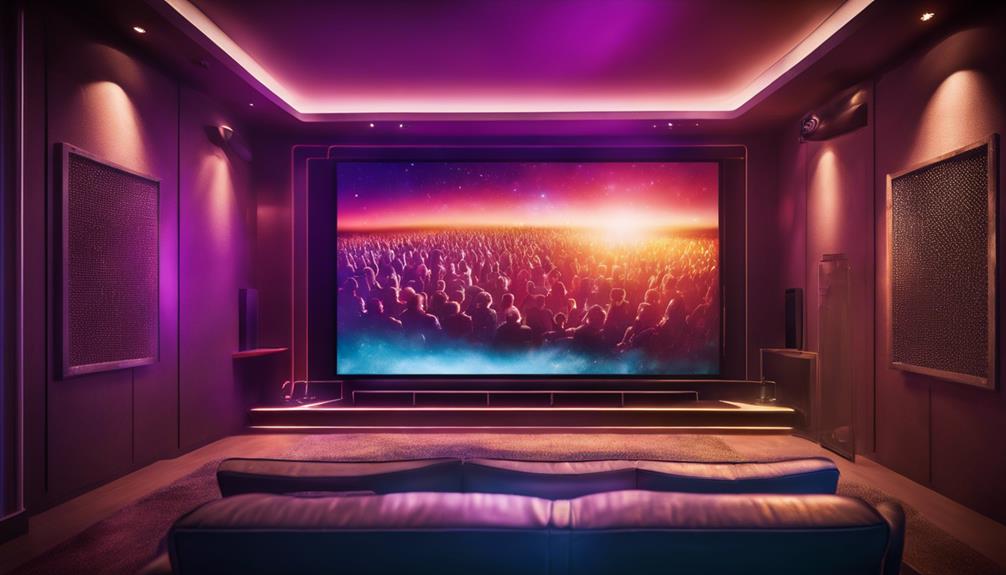
As streaming services continue to expand their HDR offerings, you'll find an ever-growing library of titles that elevate your viewing experience.
Platforms like Netflix, Amazon Prime, and Disney+ are leading the charge, providing diverse HDR content that enhances visual fidelity. Future HDR formats are on the horizon, promising dynamic metadata and improved color accuracy, which will build on existing standards like Dolby Vision and HDR10+.
This evolution isn't limited to films and shows; gaming consoles such as the PlayStation 5 and Xbox Series X are also embracing HDR technology.
This integration not only enhances the immersive cinematic experience but also elevates the visual quality of video games, making every session more engaging.
As the demand for HDR content grows, more content creators are adopting HDR in their projects, pushing the boundaries of visual storytelling.
With advancements in HDR technology, compatibility across various display devices will improve, ensuring that everyone can access and enjoy HDR content.
This accessibility will greatly enhance your overall viewing experience, allowing you to fully immerse yourself in rich, vibrant visuals like never before.
Frequently Asked Questions
Is HDR Effect Good for Movies?
Yes, HDR's effects are great for movies! It enhances colors, improves contrast, and reveals details you might miss otherwise. You'll enjoy a more immersive and lifelike viewing experience that truly brings films to life.
What Is an HDR Film?
An HDR film uses High Dynamic Range technology to enhance visuals. You'll notice brighter highlights and deeper blacks, making colors more vibrant. To enjoy them, you'll need compatible devices and high-speed HDMI cables.
What Is the Difference Between HDR and Cinema Hdr?
HDR enhances brightness and contrast for home viewing, while Cinema HDR is tailored for large screens, offering superior color accuracy and dynamic adjustments. Fundamentally, Cinema HDR provides a more immersive experience compared to standard HDR.
Conclusion
So, as you plunge into the world of HDR, just remember: it's not just about watching movies; it's about making your living room look like a high-end cinema—minus the overpriced popcorn!
With the right gear, you'll feel like you're in the movie, dodging explosions and hiding from aliens. And who wouldn't want that?
Embrace the brilliance, but try not to blind yourself while you're at it.
Happy viewing, and may your colors be ever vibrant!
Tom is the Editor-in-Chief of 1home Theatre Projector, a website that provides news and reviews on the best home cinema experiences. With over 10 years of experience in the industry, Tom knows what makes a great home theatre projector and wants to make it easy for everyone to build the perfect setup for their needs. When he’s not busy writing or testing projectors, Tom enjoys watching classic films and spending time with his family.












